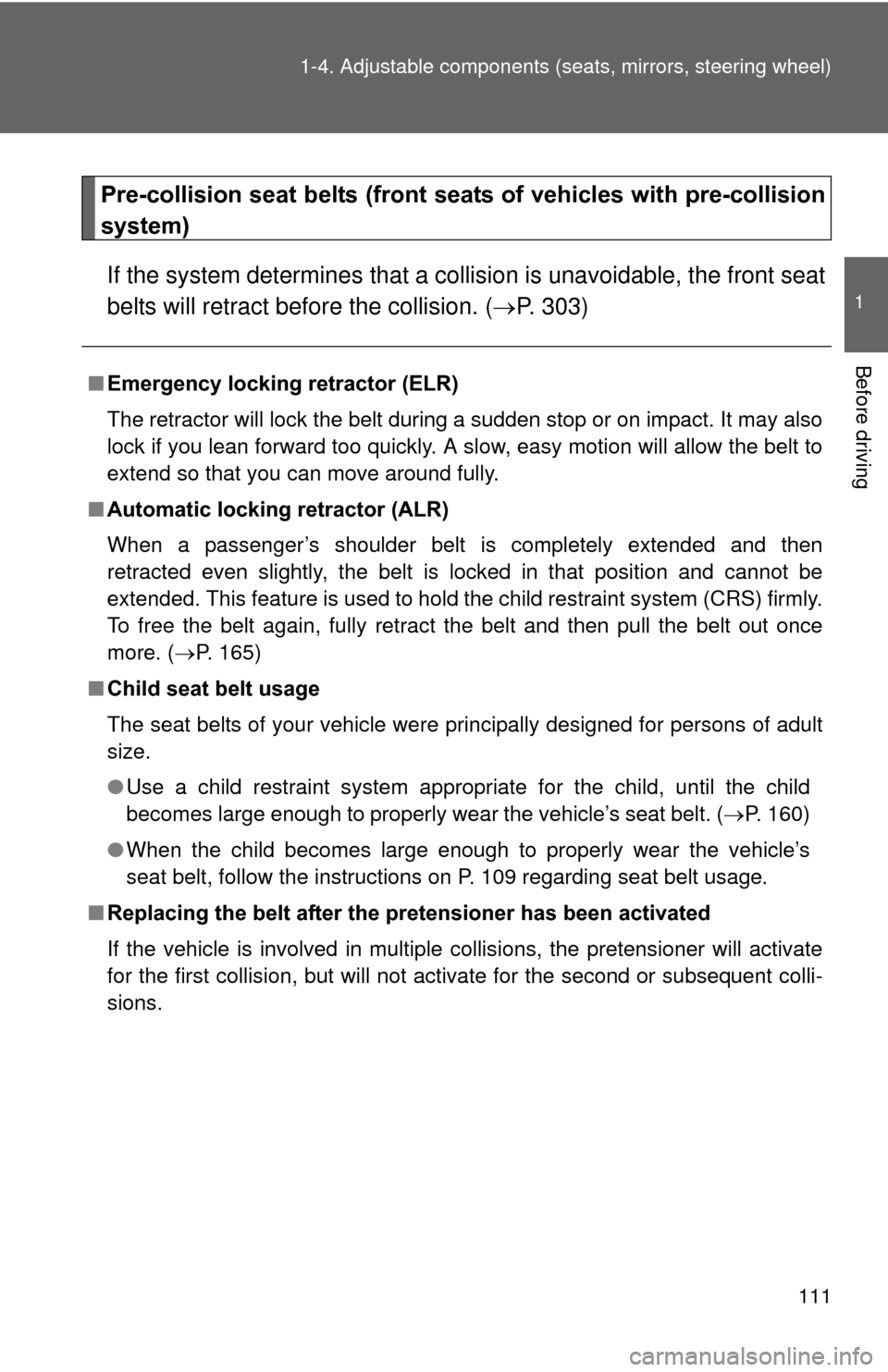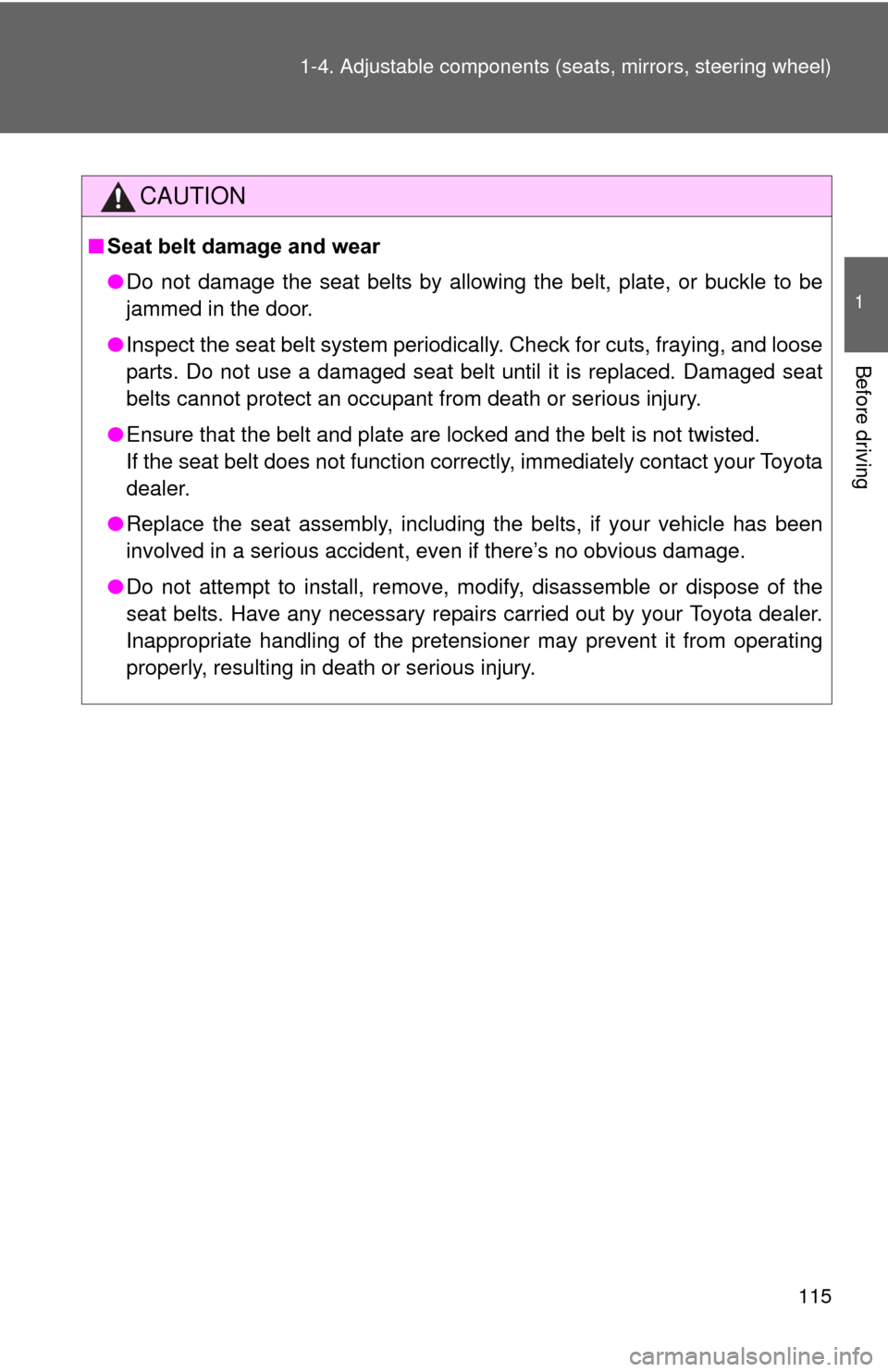Page 104 of 636
104 1-4. Adjustable components (seats, mirrors, steering wheel)
CAUTION
■When folding the seatbacks down
Observe the following precautions. Failure to do so may result in death or
serious injury.
●Do not fold the seatbacks down while driving.
● Stop the vehicle on level ground, set the parking brake and shift the shift
position to P.
● Do not allow anyone to sit on a folded seatback or in the luggage compart-
ment while driving.
● Do not allow children to enter the luggage compartment.
■ After returning the seatback to the upright position
Observe the following precautions. Failure to do so may result in death or
serious injury.
● Check that the seat belts are not twisted or caught in the seatback.
●Make sure that the seatback is securely
locked in position by lightly pushing it
back and forth.
If the seatbacks is not securely locked,
the red marking will be visible on the
seatback lock release button. Make
sure that the red marking is not visible.
Page 105 of 636
105
1
1-4. Adjustable components (seats, mirrors, steering wheel)
Before driving
Head restraints
Head restraints are provided for all seats.
Front seatsUp
Pull the head restraints up.
Down
Push and hold the lock release
button when lowering the head
restraint.
Rear center seatUp
Down
Pull up or push down the head
restraint while pressing the
lock release button.
Foldable type rear outside seats
To f o l d
Pull the head restraint up while
pressing the lock release but-
ton.
To u s e
Lift up and push down the
head restraint to the lowest
lock position.
Lock
release
button
Lock
release
button
Lock release button
Page 106 of 636
106 1-4. Adjustable components (seats, mirrors, steering wheel)
■Removing the head restraints
Front and rear center seats
Foldable type rear outside seats
Non-foldable type rear outside seats
Pull the head restraint up while pressing
the lock release button.
Lock
release
button
Pull the head restraint up while pressing
the lock release buttons.
Lock release buttons
Pull the head restraint up while pressing
the lock release button.
Lock release button
Page 107 of 636
107
1-4. Adjustable components (s
eats, mirrors, steering wheel)
1
Before driving
■Installing the head restraints
Front and rear center seats
Rear outside seats
■ Adjusting the height of the head restraints
■ Adjusting the rear cent er seat head restraint
Always raise the head restraint one level from the stowed position when
using.
Align the head restraint with the installa-
tion holes and push it down to the lock
position.
Press and hold the lock release button
when lowering the head restraint.
Lock
release
button
Align the head restraint with the installa-
tion holes and push it down to the lowest
lock position.
Make sure that the head restraints are
adjusted so that the center of the head
restraint is closest to the top of your ears.
Page 108 of 636
108 1-4. Adjustable components (seats, mirrors, steering wheel)
CAUTION
■Head restraint precautions
Observe the following precautions regarding the head restraints. Failure to
do so may result in death or serious injury.
●Use the head restraints designed for each respective seat.
● Adjust the head restraints to the correct position at all times.
● After adjusting the head restraints, push down on them and make sure
they are locked in position.
● Do not drive with the head restraints removed.
Page 111 of 636

111
1-4. Adjustable components (s
eats, mirrors, steering wheel)
1
Before driving
Pre-collision seat belts (front seats of vehicles with pre-collision
system)
If the system determine s that a collision is unavoidable, the front seat
belts will retract before the collision. ( P. 303)
■Emergency locking retractor (ELR)
The retractor will lock the belt during a sudden stop or on impact. It may also
lock if you lean forward too quickly. A slow, easy motion will allow the belt to
extend so that you can move around fully.
■ Automatic locking retractor (ALR)
When a passenger’s shoulder belt is completely extended and then
retracted even slightly, the belt is locked in that position and cannot be
extended. This feature is used to hold the child restraint system (CRS) firmly.
To free the belt again, fully retract the belt and then pull the belt out once
more. ( P. 165)
■ Child seat belt usage
The seat belts of your vehicle were principally designed for persons of adult
size.
●Use a child restraint system appropriate for the child, until the child
becomes large enough to properly wear the vehicle’s seat belt. ( P. 160)
● When the child becomes large enough to properly wear the vehicle’s
seat belt, follow the instructions on P. 109 regarding seat belt usage.
■ Replacing the belt after the pretensioner has been activated
If the vehicle is involved in multiple collisions, the pretensioner will activate
for the first collision, but will not activate for the second or subsequent colli-
sions.
Page 115 of 636

115
1-4. Adjustable components (s
eats, mirrors, steering wheel)
1
Before driving
CAUTION
■Seat belt damage and wear
●Do not damage the seat belts by allowing the belt, plate, or buckle to be
jammed in the door.
● Inspect the seat belt system periodically. Check for cuts, fraying, and loose
parts. Do not use a damaged seat belt until it is replaced. Damaged seat
belts cannot protect an occupant from death or serious injury.
● Ensure that the belt and plate are locked and the belt is not twisted.
If the seat belt does not function correctly, immediately contact your Toyota
dealer.
● Replace the seat assembly, including the belts, if your vehicle has been
involved in a serious accident, even if there’s no obvious damage.
● Do not attempt to install, remove, modify, disassemble or dispose of the
seat belts. Have any necessary repairs carried out by your Toyota dealer.
Inappropriate handling of the pretensioner may prevent it from operating
properly, resulting in death or serious injury.
Page 117 of 636
117
1
1-4. Adjustable components (seats, mirrors, steering wheel)
Before driving
Steering wheel
CAUTION
■Caution while driving
Do not adjust the steering wheel while driving.
Doing so may cause the driver to mishandle the vehicle and cause an acci-
dent, resulting in death or serious injury.
■ After adjusting the steering wheel
Make sure that the steering wheel is securely locked.
Otherwise, the steering wheel may move suddenly, possibly causing an
accident, and resulting in death or serious injury.
The steering wheel can be adjust ed to a comfortable position.
Hold the steering wheel and
push the lever down.
Adjust to the ideal position by
moving the steering wheel
horizontally and vertically.
After adjustment, pull the lever
up to secure the steering
wheel.
STEP 1
STEP 2